Bristol Tramways (Bristol Tramways and Carriage Company Limited)
History
Bristol's first horse-tram route — which opened on the 9th August 1875 — was owned by Bristol Corporation, and operated by the Bristol Tramways Company Limited. The company subsequently built various extensions itself, and experimented with steam traction (rather unsuccessfully) between 1880 and 1881. On the 1st October 1887, the BTCo merged with the Bristol Cab Company, to form the Bristol Tramways and Carriage Company Limited, which in 1892 became intimately associated with the Imperial Tramways Company, a concern which the BT&CCo's Managing Director — George White (later Sir) — had gained control of that year. The first electric service ran on the 14th October 1895, and the last horse tram on the 21st December 1900. Control of the company eventually passed to the Great Western Railway (in 1929), then to the Western National Omnibus Company Limited (a subsidiary of Thomas Tilling Limited, but with a major shareholding still held by the GWR) on the 1st October 1931, and finally to Bristol Joint Services (a joint undertaking of Bristol Corporation and the BT&CCo; on the 1st October 1937). The system closed on the 12th April 1941, ostensibly due to enemy action, though this merely accelerated a policy that the owners had been pursuing for some time.
Uniforms
Photographs taken in the Bristol Tramways Company era (1875-1887) are rare, however, those that have survived suggest that drivers wore informal but smart attire, along with the ubiquitous bowler hat; the situation with conductors is much less clear, as reasonable-quality photographs of them taken in the first two decades of operation are yet to come to light. Press reports at the opening do, however, mention the wearing of smart uniforms. The BTCo also operated a small number of steam trams, albeit for only a very short period (1880-1881), before abandoning this form of traction altogether. Drivers wore railway footplate-like attire, which in common with the vast majority of UK steam tramway operators, did not bear badges of any kind. It is currently unclear what uniforms, if any, were worn by the conductors working these services.
The uniform policy following the company's amalgamation with the Bristol Carriage Company in 1887 is also unclear, surviving photographs once again being very thin on the ground, especially with respect to conductors, with just a single example surviving. This shows a young conductor wearing a single-breasted jacket with lapels, along with a kepi-style cap. Whilst the jacket collars are devoid of insignia, the kepi style cap bears the company's initials — 'B.T.&C.C.L.' — along with what would appear to the grade, 'CONDUCTOR', both in embroidered block capitals. A handful of photographs of horse-tram drivers suggest that smart but informal attire was worn (usually a long coachman's coat) and a bowler or coachman's hat; the latter bore embroidered company initials — 'B T & C C L' — on a hat band.
Photographs taken during the early electric era (1895 to 1900) clearly show that smart uniforms were issued, both in single- and double-breasted form; it seems likely that one was intended for motormen and the other for conductors, though subsequent photographs do not support such a strict delineation. Both styles had three hip/waist-level pockets and lapels; the collars bore embroidered script-lettering system initials on both sides. Caps were in a kepi style and bore a large piped oval cloth cap badge with embroidered block capitals: 'B.T.& C.C.L' above the grade, either 'MOTORMAN' or 'CONDUCTOR'.
At some point in the early Edwardian era, a change was made to double-breasted lancer-style tunics with five pairs of buttons (see link) — narrowing from top to bottom — and with high, fold-over collars. The latter continued to carry elaborate embroidered system initials — ‘BT&CCL’ — on each side. These tunics initially appear to have lacked epaulettes, though they were soon added; the latter were edged in a light-coloured piping, and were fastened with a small button. The caps were almost certainly changed at the same time to a tensioned-crown peaked type, piped, and with a glossy peak; they carried a new oval cloth cap badge, still with ‘BT&CCL’ initials above the grade — now 'DRIVER' or 'CONDUCTOR' — but somewhat less elaborate than its predecessor.
In later years (probably the early 1920s), the jackets were changed to a more modern double-breasted style with three pairs of buttons, lapels and piped epaulettes; the oval cloth cap badge and the embroidered collar badges appear to have been superseded — probably at the same time — by a nickel ‘BT&CCL’ script-lettering company-initials badge (see below). The latter was probably transitioned to chrome prior to the demise of the tramway in 1941.
Tramcar crews, particularly motormen, frequently wore double-breasted greatcoats with piped lapels; the latter carried embroidered 'BTCCL' script-lettering badges; at some point, the design of the greatcoats was changed from one with equally spaced buttons to a lancer type, the latter with piped epaulettes. From the early Edwardian era, and when on duty, tramcar crews were required to wear municipal licence badges; these were round with black letters/numbers on a white enamel background, and bore a number (in the centre), above which appeared the words 'BRISTOL CORPORATION', and below, the bearer's grade, e.g., 'LICENSED CONDUCTOR'.
In the horse-tram era, inspectors appear to have worn double-breasted jackets with lapels and three pairs of buttons, and jacket cuffs that were embellished with braid. The jacket collars bore a badge of unknown pattern, though it may have been a metal fretwork badge of 'BT&CCL' initials, a couple of examples of which have survived (see below). Caps were of the drooping-peak type, and carried a large oval cap badge, probably of embroidered cloth and bearing the system initials and the grade. By 1900, inspectors were wearing double-breasted jackets with three pairs of buttons, a slit breast pocket, two hip-level pockets (with flap closures) and lapels; the collars bore an embroidered scroll-shaped cloth badge carrying the grade — 'Inspector' — in script-lettering within a border (initially scroll shaped, but later crescent shaped). The drooping-peak caps carried a brocade hat band and an embroidered oval cloth cap badge bearing the company initials in block letters — 'BTCCL' — above the grade, 'Inspector', all surrounded by embroidered braiding. These jackets and caps may well have been identical to those worn in the first two decades of the tramway's life.
At some point — possibly in the mid-Edwardian era — inspectors' jackets were changed to a design with stand-up collars; further details remain unknown. Inspectors' headwear was also changed around the same time, from drooping-peak caps to tensioned-crown peaked caps; these bore the same cap badge as the earlier caps, but were also piped and braided. Close-up photographs of inspectors taken during the latter years of the tramway have proven difficult to find; however, a studio portrait taken shortly after the tramway's closure (see below), suggests that in later years, inspectors wore double-breasted jackets with three pairs of buttons and lapels, the collars of which carried the grade — 'Inspector'— in embroidered script lettering. The pattern of cap badge was identical to that used in Victorian times. A similar photograph of a foreman has also survived (see below) which shows an identical uniform to the inspector, but with the grade — 'Foreman'— on the collars and on the cap badge.
At the turn of the century, inspectors were wearing double-breasted greatcoats with lapels and five pairs of buttons; the collars bore embroidered system initials, 'BT&CCL'. It is currently unclear whether the style of coat was changed in later years.
Female staff, who were employed as conductresses from 1st January 1917 to replace men lost to the armed services, were issued with double-breasted jackets with five pairs of buttons (with wider spacing at the top and bottom, and narrower in the middle). The jackets had lapels, piped epaulettes and piped cuff straps; the collars bore curved, embroidered cloth badges: 'Conductor' on the bearer's left-hand side and 'BT&CCL' on the right, both within a border. A long matching skirt was also worn, along with button-closed gaiters. Headgear cam in two varieties, baggy motor caps (with a glossy peak), and wide-brimmed felt bonnets, the former possibly for winter wear and the latter for summer wear. Both hats bore a round, embroidered cloth cap badge comprising a monogram of the system initials, 'BT&CCL', within a circle. The ladies were also issued with long, tailored, double-breasted topcoats with six pairs of buttons (with wider spacing at the top and bottom, and narrower in the middle), high, fold-over collars, epaulettes and cuff straps, both the latter piped; the collars bore the same curved cloth badges as the jackets.
The BT&CCo probably also employed inspectresses. They appear to have been provided with long double-breasted top coats with lapels; the buttons were widely spaced at the top and bottom, but narrowed towards the middle (waist). These garments were embellished with light-coloured sleeve chevrons and piped epaulettes; the collars probably bore the grade, though this cannot be made out on the one surviving photograph. The baggy caps had a glossy peak and bore a badge of unknown pattern, though very probably embroidered.
Further reading
For a history of Bristol's tramway system, see: 'Bristol's Trams Remembered' by John B Appleby; published by the author (1969).
Images
Horse tram drivers and conductors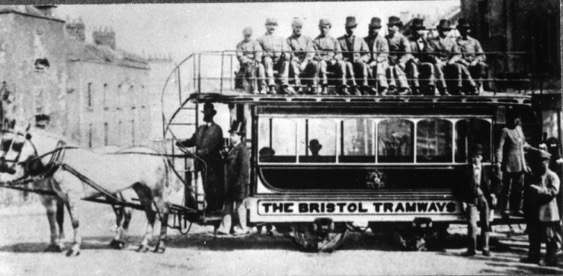
An unidentified Bristol Tramways Company horse tram at Perry Road curve on the inaugural run on 9th August 1875. Although it is claimed that drivers and conductors wore grey uniforms trimmed with scarlet, the driver here appears to be wearing informal attire. It is unclear whether any of the other figures, none of whom appears to be wearing a uniform, is the conductor. Photo courtesy of the Tramways and Light Railway Society.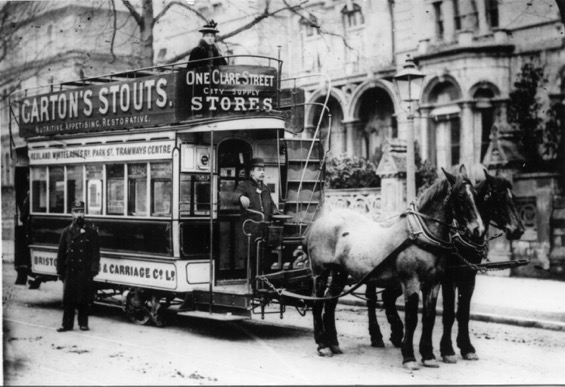
A BT&CCoLtd driver and an inspector (standing to the left), with a tram in the 119-124 series (built in 1896), working the Redland-Tramways Centre route — photo undated, but probably taken in the late 1890s. The conductor is standing on the rear platform. Photo courtesy of the Tramways and Light Railway Society.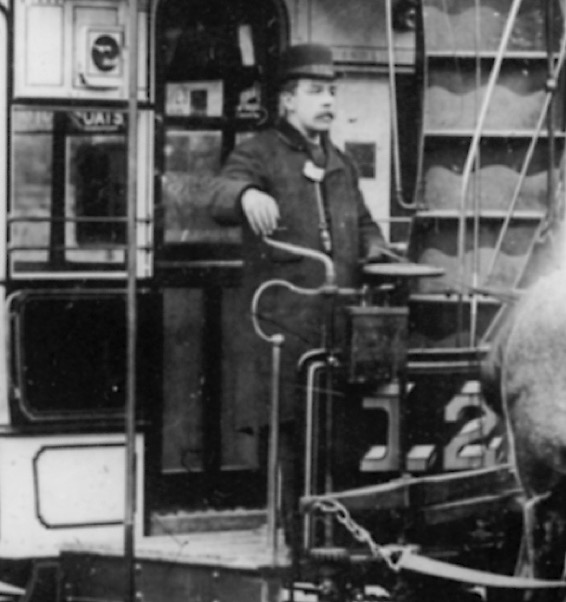
An enlargement of the above photograph showing the driver, who appears to be wearing smart but informal attire. His bowler hat does, however, has a hat band, which from other photos, bore 'B T & C C L' in embroidered letters.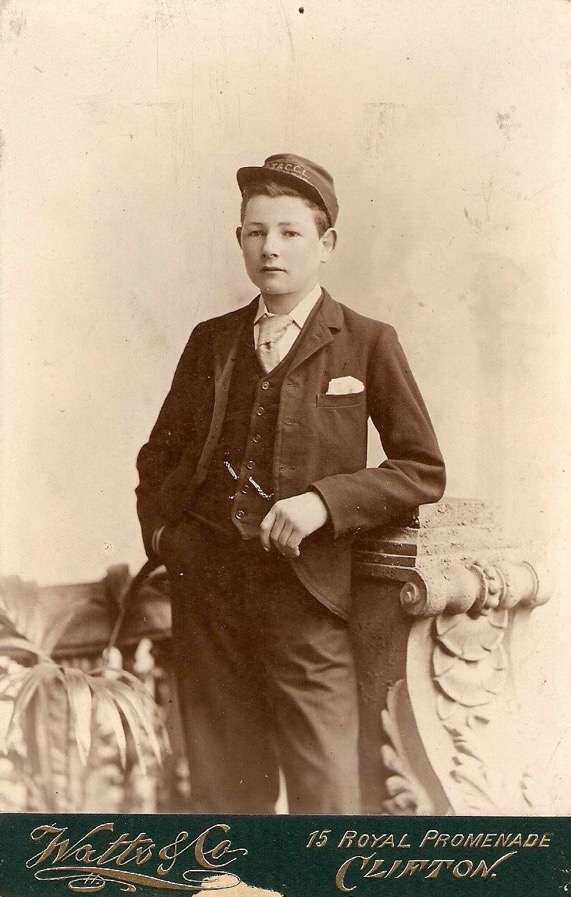
A rare studio portrait of a young BT&CCoLtd employee, very probably a horse-tram conductor. Although the photograph is undated, it is definitely no earlier than 1887, when the company was formed, and no later than 1900, when the last horse tram ran. In all likelihood, however, it was taken prior to the introduction of new uniforms at the commencement of electric services in 1895. Photo courtesy of Mike Stenner.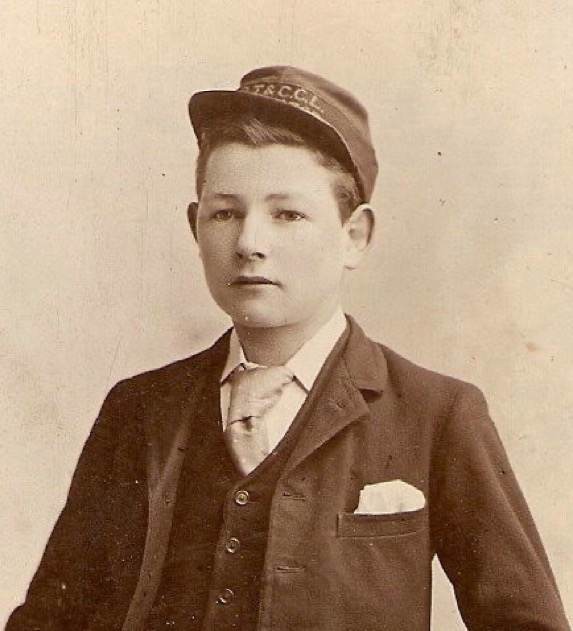
An enlargement of the above photograph showing the kepi-style cap, which appears to bear the company's initials, 'B.T.&C.C.L.', and the grade, 'CONDUCTOR', both in embroidered block capitals.
Two passing horse trams, with a conductor on the left one (No 58) and a driver on the right-hand one. The uniformed man standing in the road is more than likely an inspector or timekeeper. Photo courtesy of the Tramways and Light Railway Society.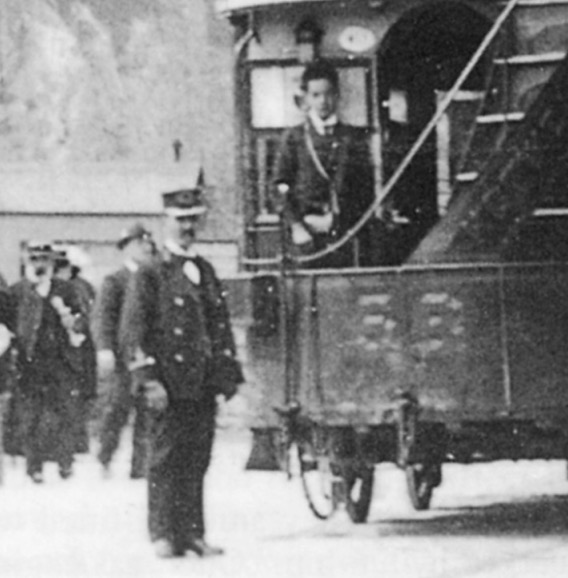
An enlargement of the above photograph showing the inspector/timekeeper and the rather youthful-looking conductor; the latter would appear to be wearing informal attire, though this is far from clear.
Steam tram drivers and conductors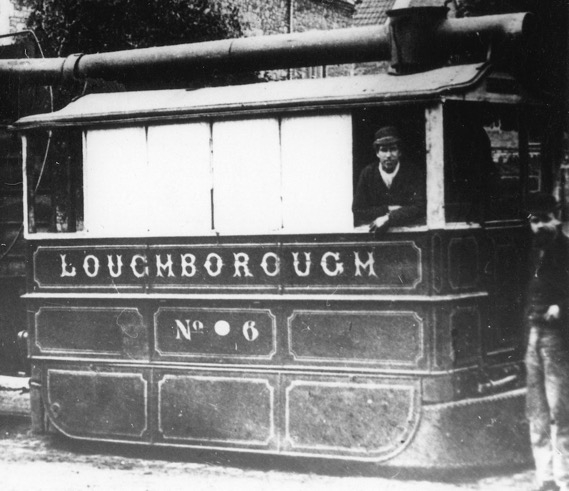
Bristol Tramways Company Steam Tram No 6 'Loughborough' — on hire from the manufacturer (Hughes), captured for posterity in either 1880 or 1881. The driver is wearing typical workman-like footplate attire, without insignia. Author's Collection.
Motormen and conductors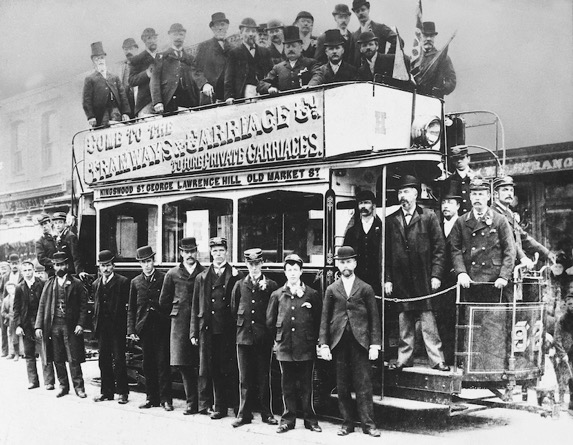
Tramcar No 92 and a crowd of staff and worthies captured on what may well be the opening day of electric services on 14th October 1895. With thanks to the National Tramway Museum. 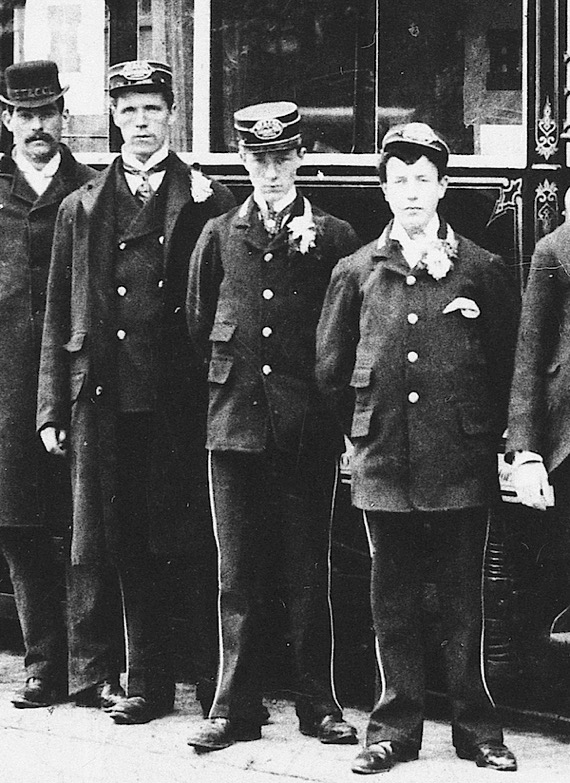
An enlargement of the above photograph showing four tramwaymen. The individual on the left is wearing a coachman's hat with a hat band bearing embroidered initials — 'B T & C C L' — suggesting that he is a horse-tram driver. The three individuals to his left are all in smart kepis and piped trousers, two in single-breasted jackets and one in a double-breasted jacket.
A studio portrait of a BT&CCL conductor — photo undated, but probably taken in the mid-to-late 1890s. Both the cloth cap badge and the collars bear embroidered insignia. Source unknown.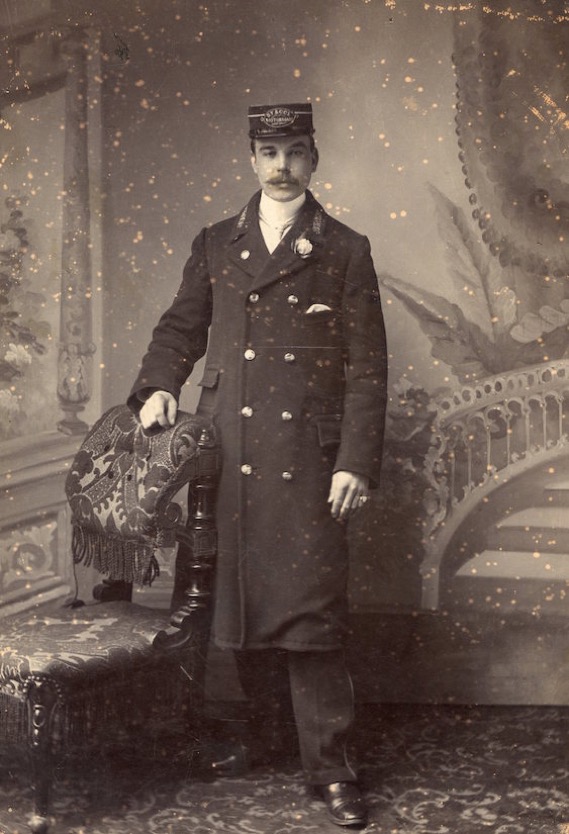
A studio portrait of a rather earnest-looking BT&CCL motorman — photo undated, but probably taken before the turn of the century. Photo by B Lapidaire & Co, 19 Old Market St, Bristol; Author's Collection.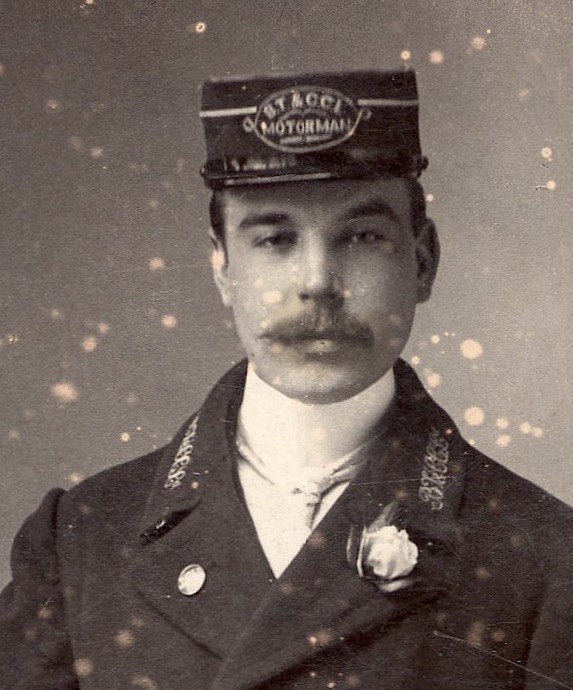
An enlargement of the above photograph showing details of the embroidered collar and cap insignia.
Conductor William Cross (born 1879) poses for the cameraman with an unidentified tramcar in what may possibly be Gloucester Road, outside the Horfield Road tram depot — photo undated, but very probably taken around the turn of the century, given that the tramcar appears to belong to one of the batches delivered in 1900/1901, and which still has its curtains (these did not last long). Bill Cross later became a motorman and ultimately, an omnibus driver.
A brand-new Tramcar No 199 (and crew) pictured at Hanham in 1900/1901. The motorman appears to be wearing an informal jacket, but with the standard-issue cap. With thanks to the National Tramway Museum.
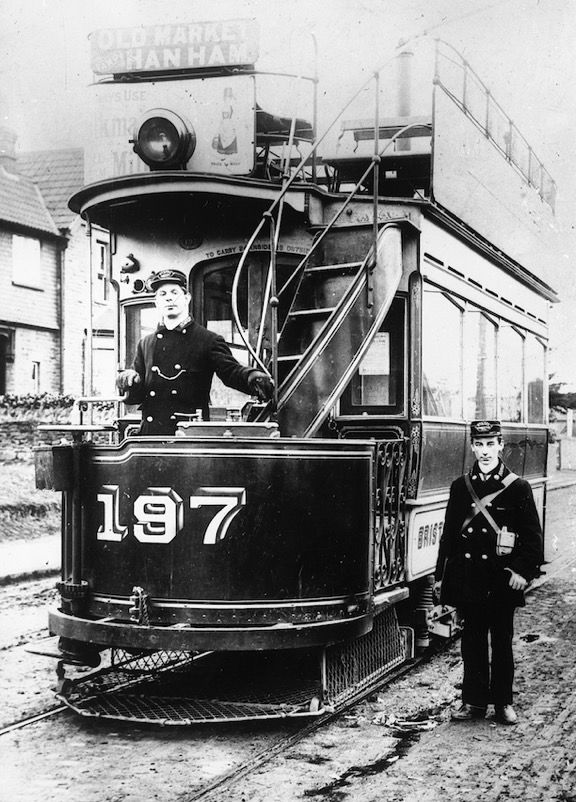
A pristine-condition Tramcar No 197 and crew, again pictured in 1900/1901. With thanks to the National Tramway Museum. 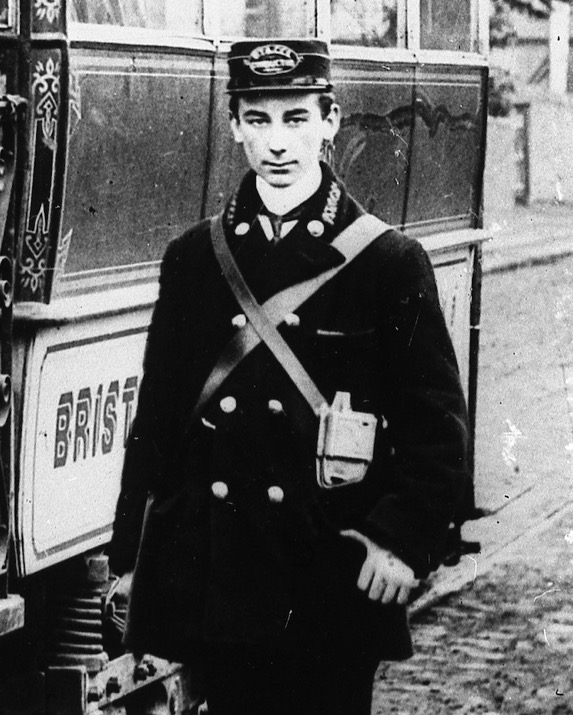
An enlargement of the above photograph showing the conductor.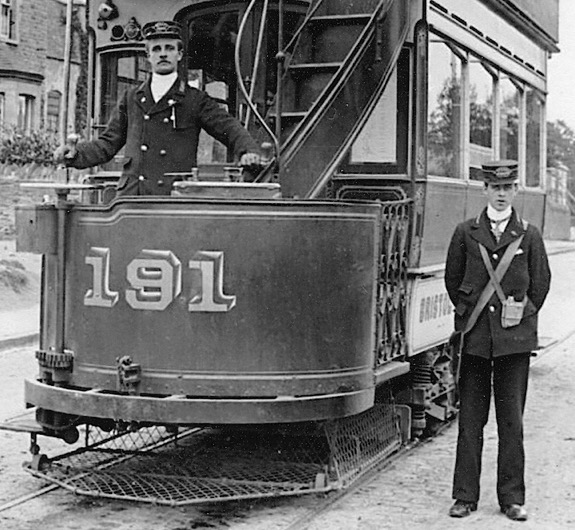
A motorman and a conductor with Tramcar No 191 — photo undated, but probably taken in 1901/2. The conductor in this photo is wearing a single rather than a double-breasted jacket. Neither man is wearing a municipal licence badge, suggesting that they had yet to be introduced. Author's Collection.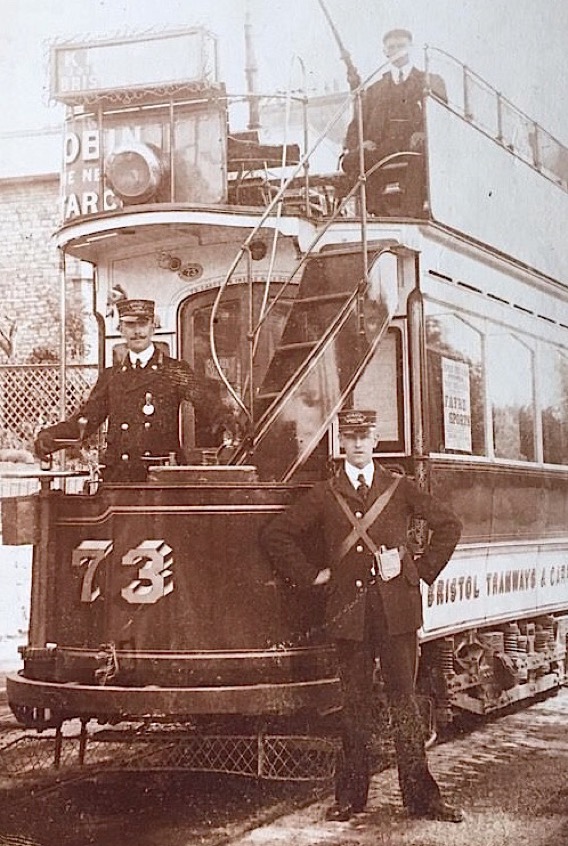
Tramcar No 73 with crew — photo undated, but probably taken shortly after route indicator boxes were fitted in 1902. The motorman's municipal licence badge is clearly in evidence. Source unknown.
Tramcar No 95 with crew — photo undated, but once again, probably taken shortly after route indicator boxes were fitted in 1902. Both men are wearing licence badges, the conductor's attached to a single-breasted jacket. Source unknown.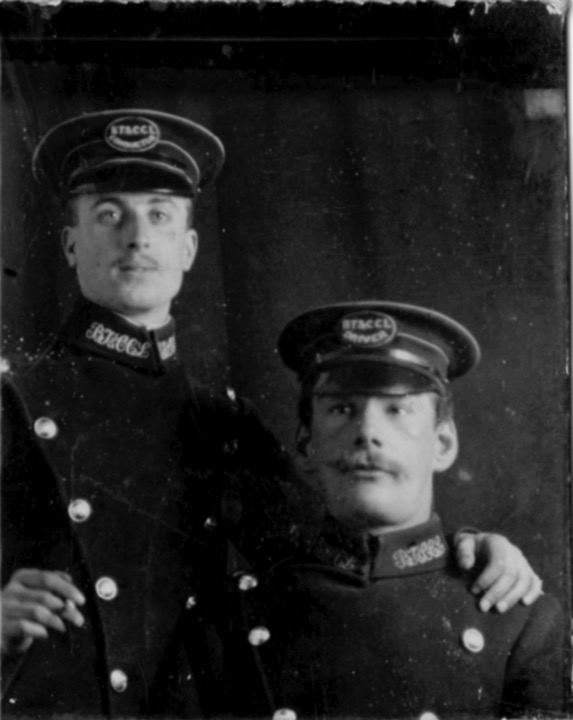
Conductor Knight and Motorman Causey in the new double-breasted, lancer-style tunics and tensioned-crown peaked caps — photo undated, but probably taken in the mid-Edwardian era. Both men's tunics lack epaulettes, which appear to have been introduced slightly later. Author's Collection. 
An outdoor portrait of a BT&CCL conductor — photo undated, but probably taken in the mid-Edwardian era. Although the trousers and cap are piped, the tunic does not bear epaulettes. Author's Collection.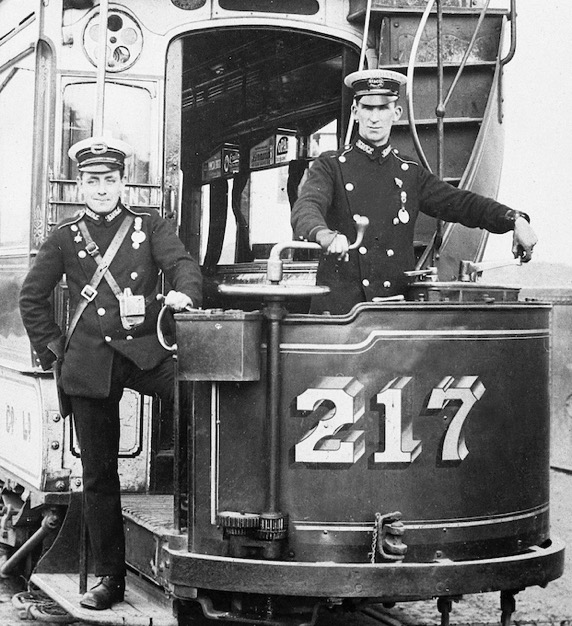
Conductor J D Hare of Bedminster and his motorman pose for the camera with what appears to be a fairly new Tramcar No 217. Although undated, the vehicle still has its original McGuire Columbian truck (these were quickly replaced), so it was probably taken in the mid-Edwardian era. Both men are wearing lancer-style tunics bearing piped epaulettes. With thanks to the National Tramway Museum.
A rare photograph of a tramcar crew in double-breasted, lancer-style greatcoats — photo undated, but probably mid-to-late Edwardian. Source unknown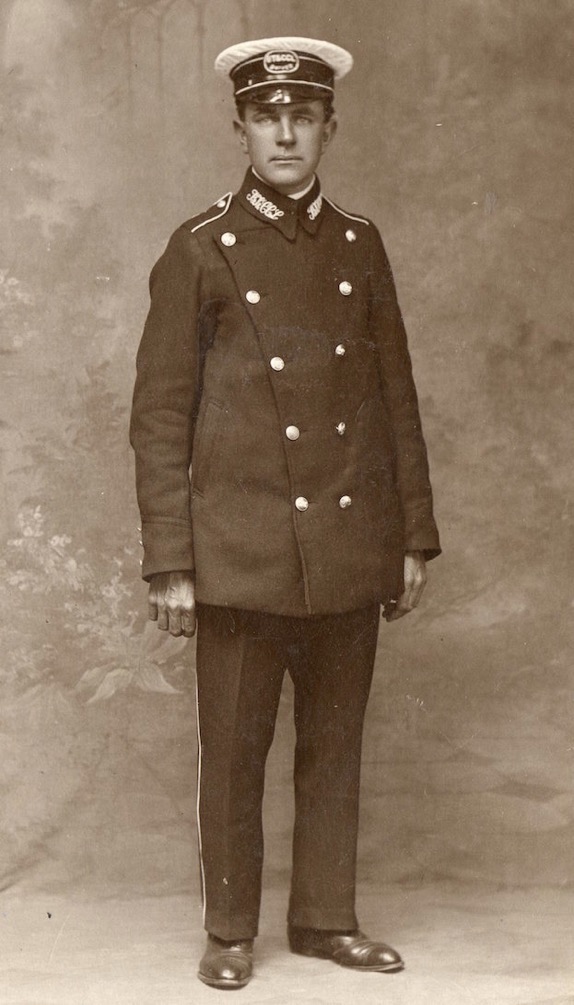
A studio portrait of a BT&CCL motorman in double-breasted, lancer-style tunic — photo undated, but probably mid-to-late Edwardian. The tunic now has piped epaulettes, and the piping around the cap meets the cap badge half-way up rather than towards the top of the badge. Author's Collection.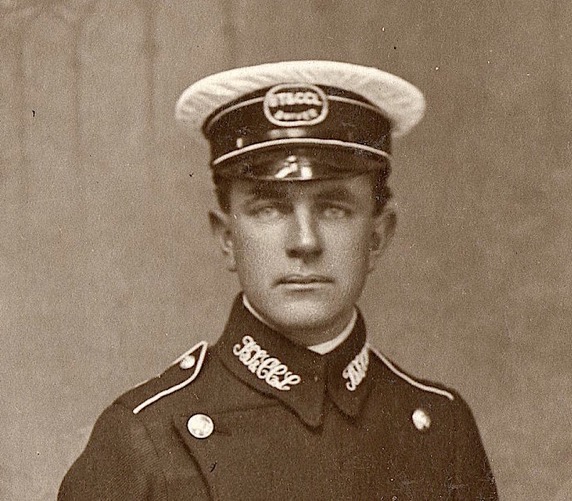
An enlargement of the above photograph showing the uniform insignia. The system initials on the collar are embroidered, as is the cloth cap badge, which again bears the company initials, along with the bearer's grade. Magnification shows the buttons to be the standard script-lettering company-initials pattern (see link).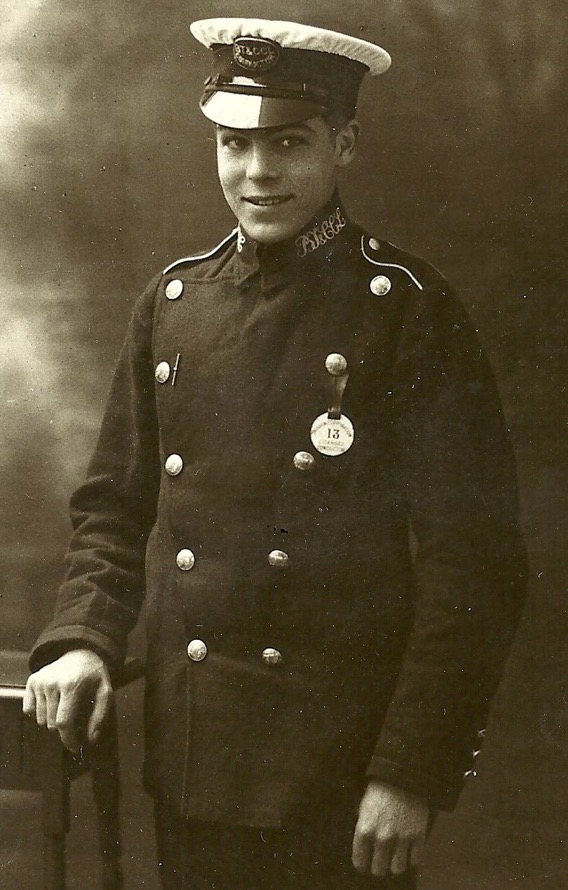
Bristol conductor No 13 — photo undated, but probably taken around the time of the Great War. The wiring on the licence is: 'BRISTOL CORPORATION, 13, LICENSED CONDUCTOR'. With thanks to Stephen Howarth.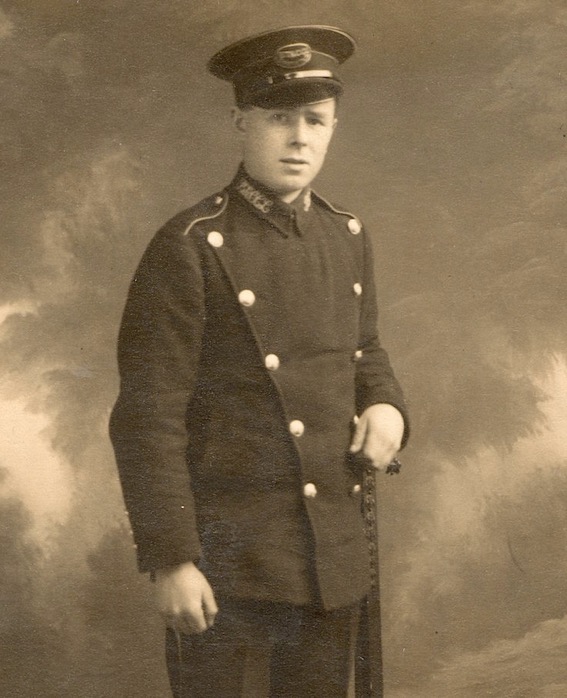
An unidentified BT&CCL conductor — photo undated, but possibly taken after the Great War. Author's Collection.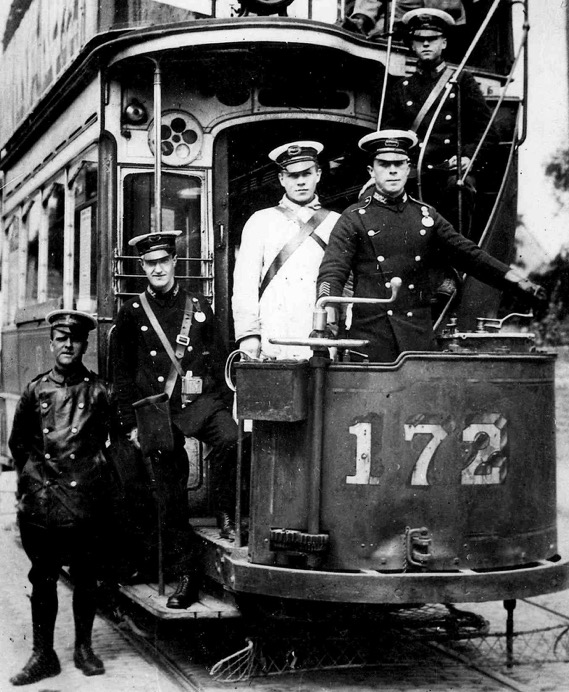
Bristol Tramways staff posing with Tramcar No 172 on Service 6 at the Filton terminus — photo undated, but probably taken just after the Great War given the attire of the passengers (not shown) and the condition of the tramcar. The man at the controls is the motorman, whilst his conductor stands on the platform steps (2nd left); the figure on the staircase is possibly a points boy. The other two individuals are almost certainly a bus driver (1st left) and a bus conductor (in the white coat), probably for the connecting service to Thornbury (thanks to Peter Cook for this information). Note the small licences worn by the conductor (2nd left) and the motorman (4th left), as well as the chevrons adorning the sleeve of the latter. Author's Collection.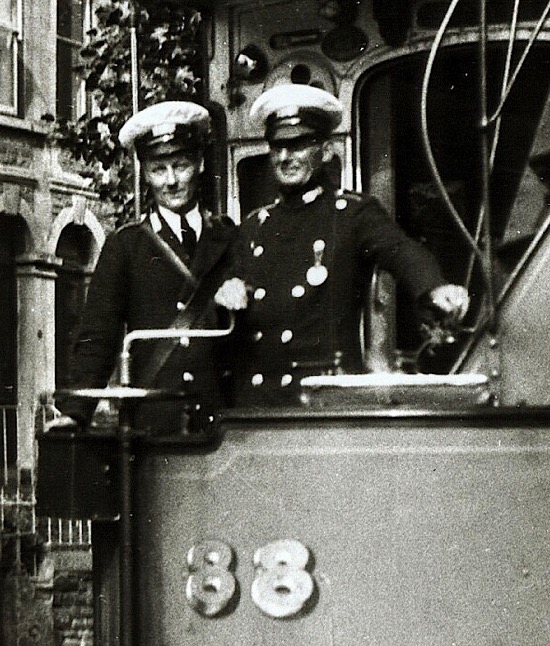
A conductor and a motorman aboard Tramcar No 88 in Zetland Road — photo dated 1924. The cloth cap badge and embroidered collar badges had by this time been replaced by a nickel, script-lettering badge, 'BT&CCL'. Source unknown.
BT&CCL collar and cap badge — chrome. It is likely that these badges were initially issued in nickel, transitioning to chrome in the 1930s. Author's Collection.
A Bristol Tramways and Carriage Company Limited 1901 loyalty medal. The material this is made from is unclear; although some records suggest that they were silver, the medal is not hallmarked, so this seems unlikely. The medals were actually issued at the behest of George White (chairman of the BT&CCL) who was a vociferous opponent of unions. They were given as a reward to ‘loyal employees’ who had not gone on strike in support of their colleagues who had been dismissed for joining the local branch of the National Union of Gasworkers and General Labourers. 
The rear of the above medal showing the recipient, Conductor P A Orchard.
Senior staff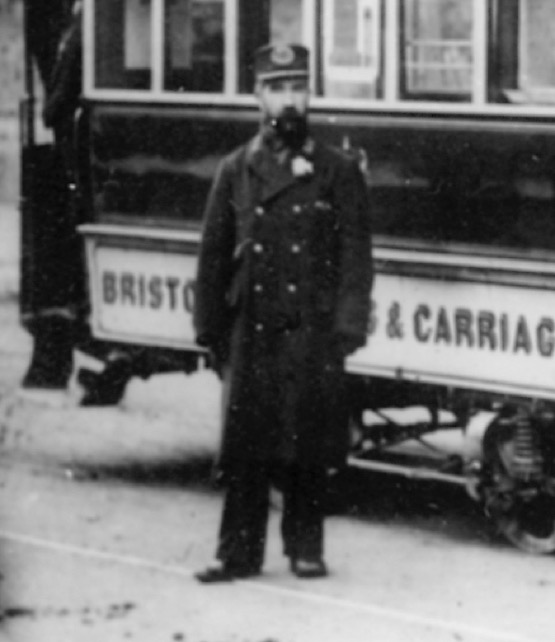
An enlargement of the 120-series horse tram photograph above, showing an individual who is almost certainly an inspector, regulator or timekeeper. His tall drooping-peak cap bears a large oval cap badge — probably embroidered cloth — and the collars of his overcoat also bear badges, almost certainly embroidered 'BT&CCL' initials.
Possible inspector's BT&CCL' collar badge from the pre-electric era — gilded brass. Author's Collection.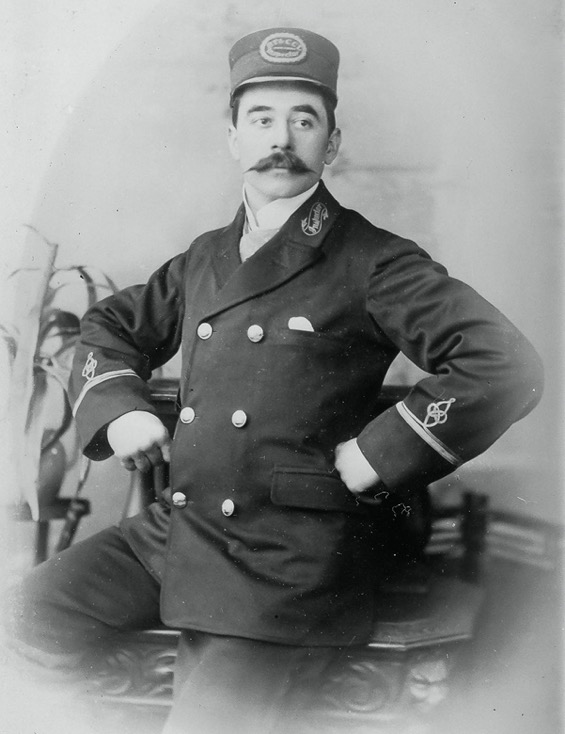
A studio portrait of Inspector William Clement, probably taken to celebrate his promotion to the grade of Inspector, circa 1900. William Clement was born in Chew Magna in Somerset in 1869, so would have been about 30 years old when the photograph was taken. He started with the Bristol Tramways Company circa 1882, possibly as a stable lad, and after a brief period working as a coachman in the late 1880s, he returned to the tramway, first as a conductor, then moving onto driving, before attaining the grade of inspector. In subsequent years, he also worked as a foreman (of St George's Depot), a tramways traffic inspector, and latterly as a bus timetabler, retiring in 1935; he died in 1964 aged 95 years. Photo and biographical information courtesy of Penny Hurt, William's great grand-daughter.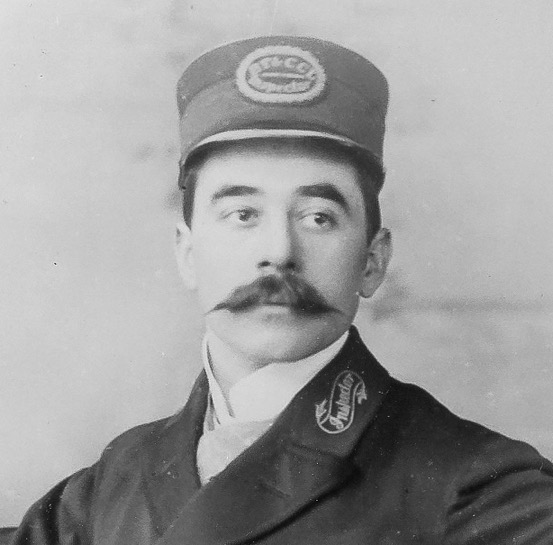
An enlargement of the above photograph showing details of the jacket and cap. The cap bears a cloth badge with the company initials and grade, all embroidered; the collar badge is likewise embroidered cloth, bearing the grade within an elaborate scroll-shaped border.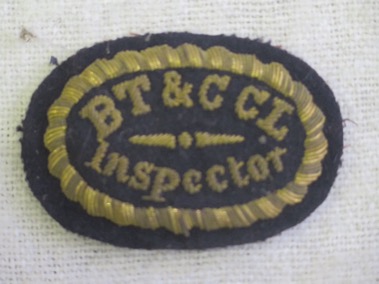
A BT&CCL inspector's cap badge — embroidered cloth. Peter Davey Collection, courtesy of Rob Jones.
A superb portrait of a BT&CCL inspector (named Edward), taken in the studios of R Prachett. The subject is wearing a 1901 'loyalty' medal, strongly suggesting that the photograph was taken in 1901 or 1902. Author's Collection.
An enlargement of the above photograph showing details of the uniform and cap insignia. The grade on the subject's collar is borne within a crescent-shaped border rather than the earlier scroll-shaped border.
A lovely studio portrait of an unknown BT&CCL inspector — photo undated, but given that he is wearing a tensioned-crown peaked cap rather than a drooping-peak cap, it was probably taken around 1903-5. Although his jacket cannot be seen, the fact that his shirt and tie are obscured, means that it certainly bore stand-up collars; the wide stripe on his trousers, which is clear to see, was almost certainly of a contrasting colour to the main material. Author's Collection.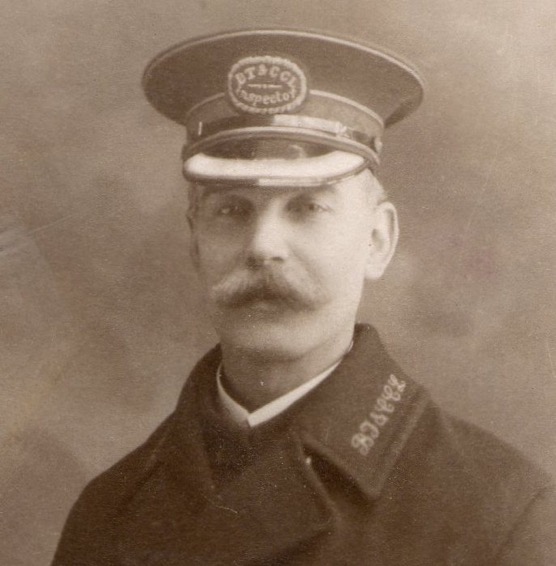
An enlargement of the above photograph showing details of the cap and collar insignia.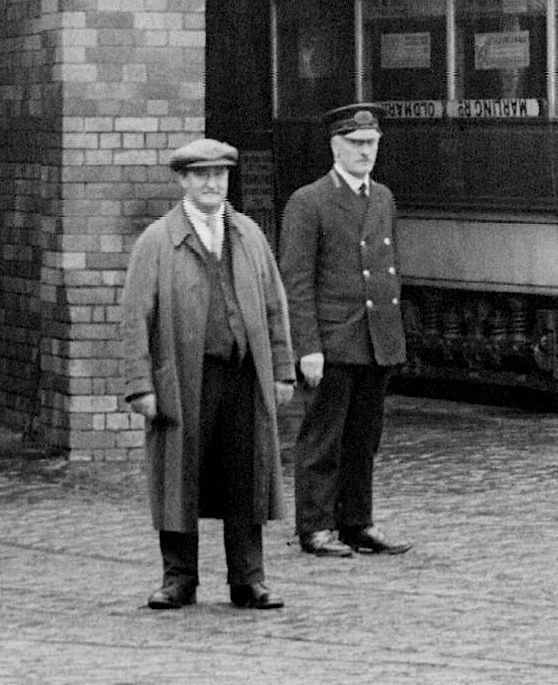
An inspector (right) pictured at Horfield depot circa 1938. Photo by W A Camwell, courtesy of the National Tramway Museum. 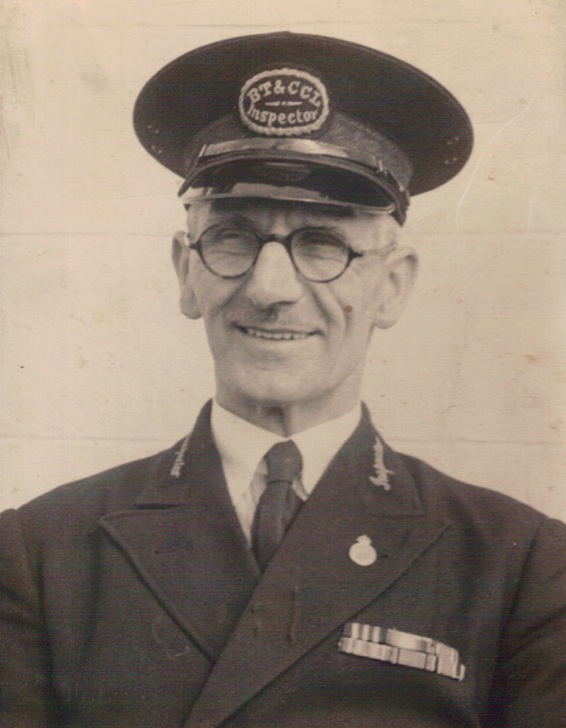
Inspector Gilbert Edwin Charles Pitt MM, who started work on the trams in Bath, eventually retiring as an inspector on the buses, also in Bath (by that time operated by the BT&CCL). Although the photograph was taken shortly after the Second World War, and therefore post-dates the demise of the trams, the uniform is probably unchanged from that worn by inspectors during the latter decades of tram operation in Bristol. The cap badge is in fact completely unchanged from that in the 1903-5 photograph above. With thanks to the subject's Grandson, Tony Pitt. 
Another photograph that post-dates the tramway, this time of a foreman. The uniform is identical to that worn by inspectors, save for the grade embroidered on the jacket collars and the cap badge. Photograph courtesy of the Stephen Howarth Collection.
Female staff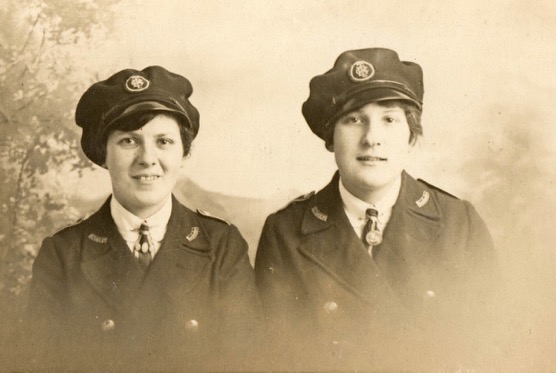
A studio portrait of two BT&CCL conductresses taken at Gale's Studios Ltd — photo undated, but almost certainly taken during the Great War. Author's Collection.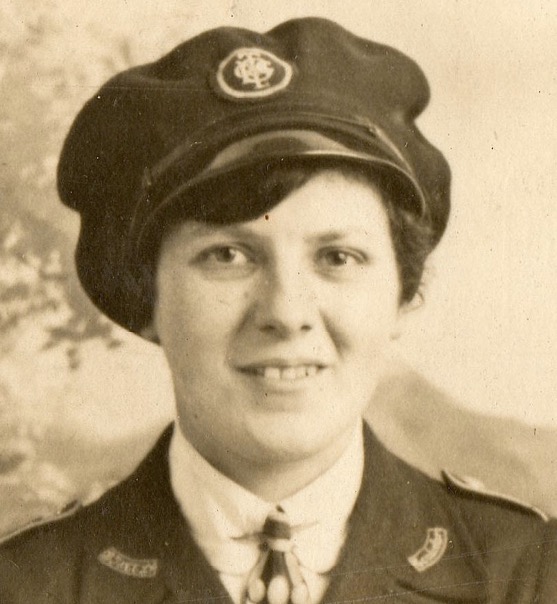
An enlargement of the above photograph showing the lady on the left. Her cap badge is embroidered cloth and comprises a monogram of the system initials, 'BT&CCL'. The collar badges are also embroidered cloth: 'Conductor' on her left-hand side and 'BT&CCL' on her right-hand side.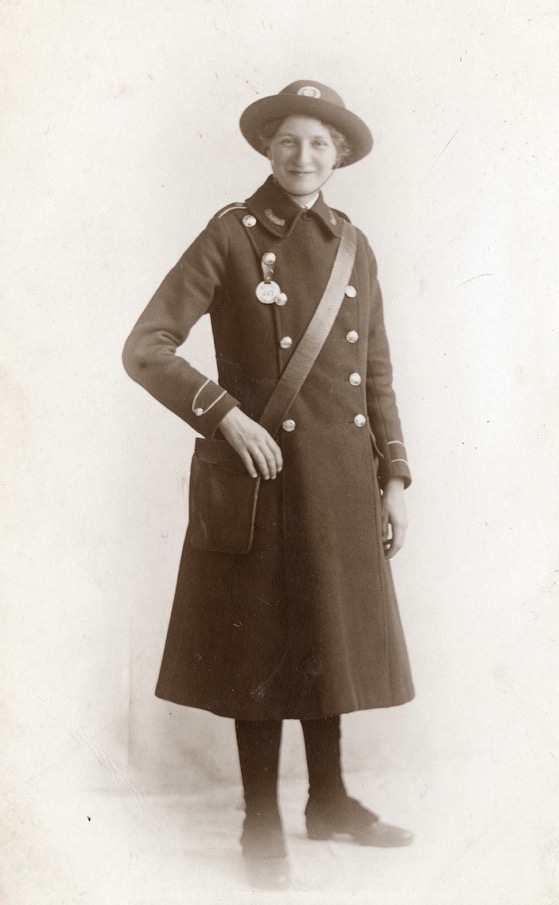
A studio portrait of a Great War Bristol Tramways conductress in long, tailored topcoat. Author's Collection.
An enlargement of the above photograph showing details of the licence, collar badges and hat, which is a felt bonnet rather than the baggy motor cap seen in other photos. 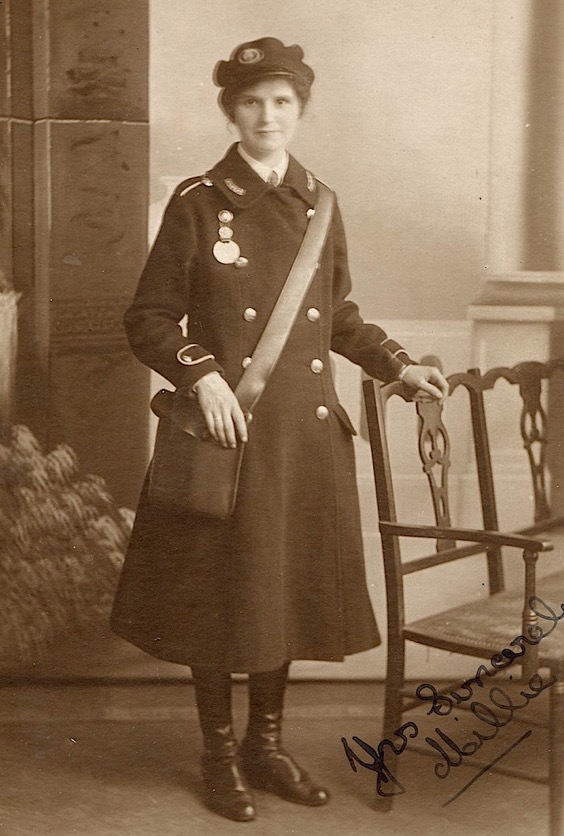
Another studio portrait of a Bristol conductress, this time of a lady called Millie — photo undated, but almost certainly taken during the Great War. Photo by Hamilton of Staple Hill, Bristol; Author's Collection.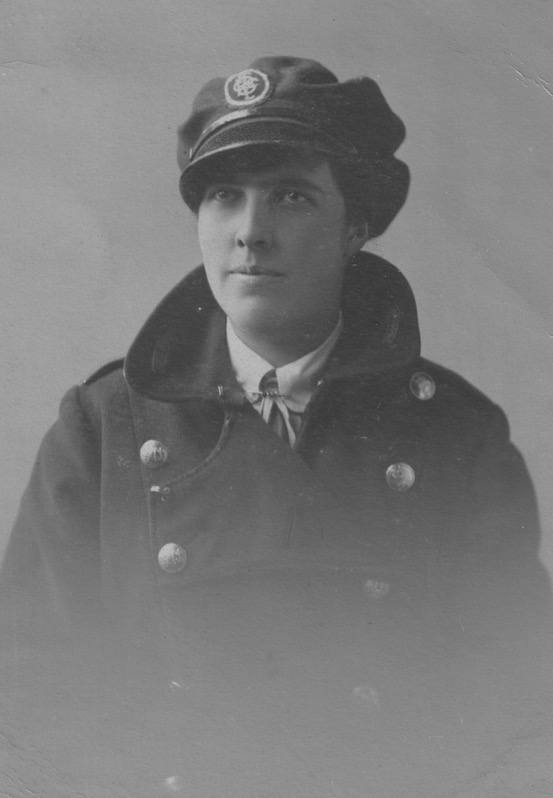
A BT&CCL Great War conductress in distinctive topcoat with buttons that narrow in the middle, taken at the studio of H M Veale and Co., Bristol. Author's Collection.
A studio portrait of an unknown BT&CCL Great War conductress. The subject is wearing a piped jacket rather than a long topcoat, along with a matching skirt and gaiters. Photo courtesy of the Geoff Caulton Collection.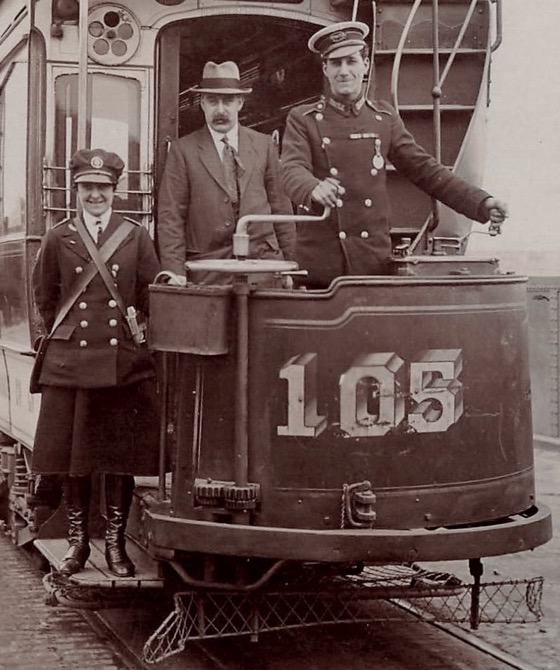
Tramcar No 105 and its crew on a service between Bristol Bridge and Ashton Road — photo undated, but probably taken late in the Great War or shortly afterwards, as the motorman is wearing his medal ribbon. Unusually, the conductress is not wearing the long topcoat that the conditions usually demanded.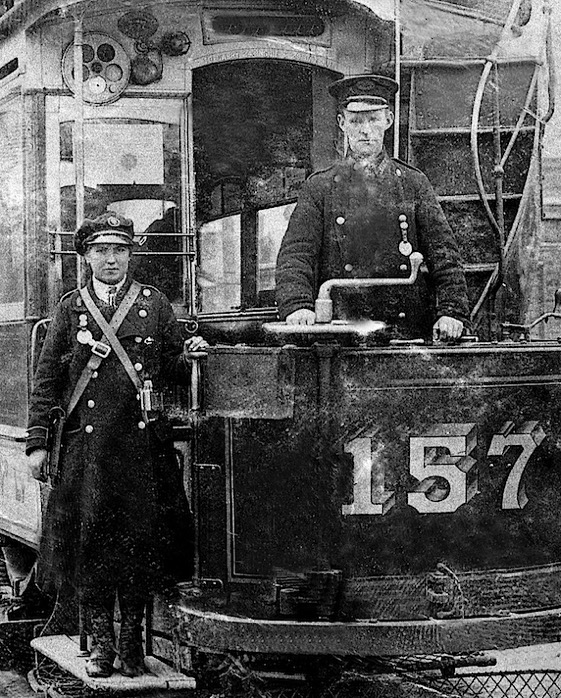
A Great War BT&CCL conductress aboard Tramcar No 157, on the Staple Hill/ Zetland Road route. With thanks to the National Tramway Museum.
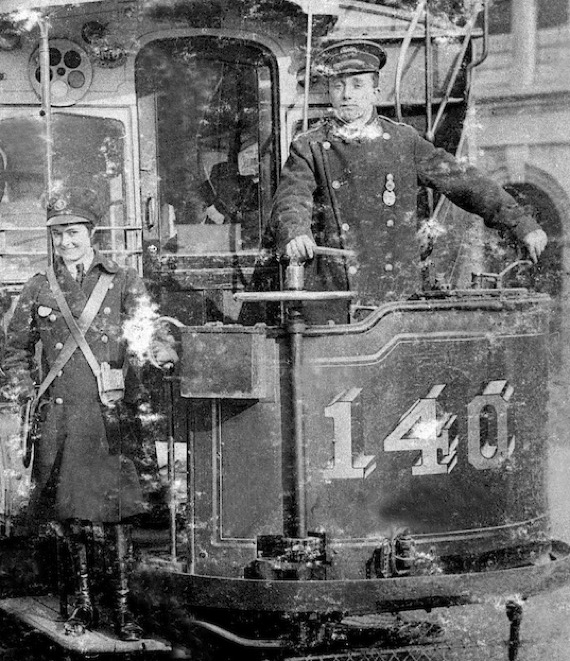
Another damaged photograph, this time showing a rather smiley conductress aboard Tramcar No 140 — photo undated, but very probably taken during the Great War. With thanks to the National Tramway Museum. 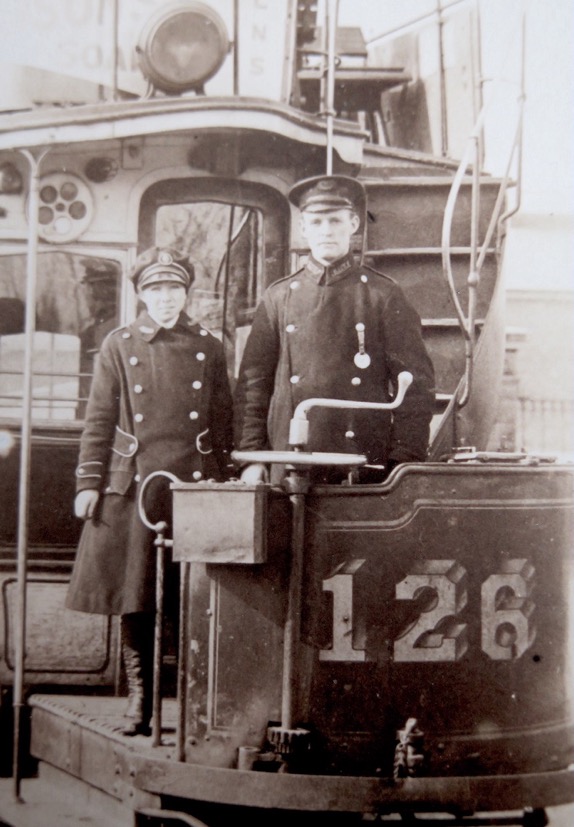
Another shot of a Great War BT&CCL conductress and her motorman, this time on the platform of Tramcar No 126. Peter Davey Collection, courtesy of Rob Jones.
Tramcar No 105 with a conductress, a motorman, and a lady who is in all probability an inspectress.
An enlargement of the above photograph showing the inspectress.